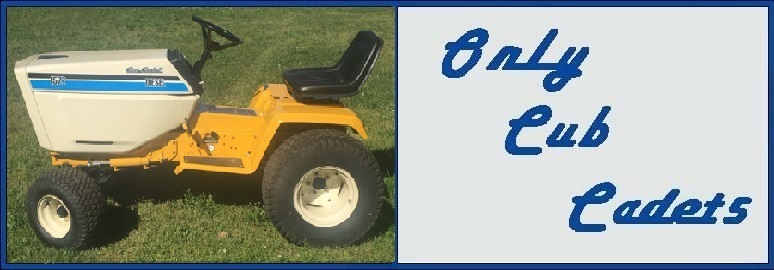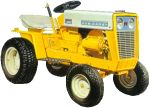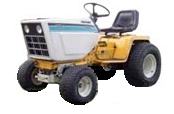
 |
PLEASE PATRONIZE OUR SPONSORS!






|
|||||||
 |
|
|
Thread Tools | Display Modes |
|
#11
|
|||
|
|||
|
I may be wrong or wronger, but I adjust mine to grip ASAP if the peddle is pushed since I NEVER use it unless its a total panic situation (see my recent thread about my hydro handle going around like a roulette wheel... cub vs. TJ/house/whatever damage, TJ/house/whatever wins every time if I get a choice). I'm not outrunning neutral, but mine are adjusted CLOSE. If you mess it up you'll know right away because the hydro will whine with the brake depressed or the pads will drag. Put the rear up on a jack and spin the wheels by hand to make sure the pads are free.
Yes, its totally possible your linings are toast and that they need replaced, but you should be able to adjust them all the way down to nearly (or all the way... never tried) metal on metal if you want. There are procedures to replace the linings, but sadly you can't just buy new pads like you can for a car. NLA. As plenty of others have said, you should practically NEVER need to use the brakes on hydro tractor. If it's not stopping under reverse load, it ain't gonna stop anyhow because you're out of traction. I experience this every single time I mow my hill and duals aren't practical for the rest of my property so we go down fast and up slower. 
|
|
#12
|
|||
|
|||
|
Quote:
As soon as you place the Hydro lever in neutral......you WILL stop.
__________________
[B]Roland Bedell[/B] CC Models: 100, 105, 1450, 782, (2) 784, & 2072 [SIZE="4"][B][COLOR="Red"]Buy:[/COLOR][COLOR="Blue"] Made in the USA[/COLOR][/B] [/SIZE]:American Flag 1: |
|
#13
|
||||
|
||||
|
Quote:
__________________
|
|
#14
|
|||
|
|||
|
Quote:
On some of my older Narrow Frame tractors the pedals are EXTREMELY difficult to push down if the lever is in the forward position, and they are a PITA to fix, so I don't mess with them unless I have the dash apart for some reason. I don't know if that's the reason for not using the pedal or not, but in any event, my hand is always on the lever anyway. I would bet that 9 out of 10 times, if I'm going to stop (for whatever reason), the next step is reverse anyway. There is no reason to step on the pedal then let off, then pull the lever backward.'' It's all one motion with little or no pause in the middle. I guess some could say that I'm hard on my hydro transmissions and I may be... But, I have yet to break one. I have yet to replace brake pads either...
__________________
More IH Cub Cadet Parts RIGHT HERE |
|
#15
|
|||
|
|||
 Brake lining is available from McMaster-Carr. Brake lining is available from McMaster-Carr. 
__________________
Don B, USAF 1962-1968, Ft. Wayne, IN |
|
#16
|
||||
|
||||
|
One reason the IH Engineers developed a internal and or external brake system can be found in the manual:
Blue Ribbon Service Manual International Cub Cadet Tractors Models 86, 108, 109, 128, 129, 149, 169, 800, 1000, 1200, 1250, 1450, & 1650 GSS-1464 W/ Revision 2 September, 1979 Aside from a safety parking brake, or engine failure on a down-hill slope, the following paragraph under the Check Valve Service chapter located on page 2-40 states this: NOTE: Late production tractors are equipped with self-unloading check valves in the hydrostatic transmission. The tractors so equipped cab be identified by the absence of a release lever on the right side of the frame cover. These check valves will dump automatically when the engine is shut off. This will allow the tractor to be rolled. CAUTION: Any time the engine is shut off the brake pedal should be locked to prevent the tractor from rolling. Makes perfect sense why IH done what they did! Especially if the model 129 in topic discussion was up-graded to the self-unloading check valves. My personal opinion for my early 1450, is to go with the self-unloading check valves once the current manual check valves can no longer be operational. I find it very difficult to push the 690 pound beast with one arm, and hold the dump lever with the other arm when something prevents the tractor from self operation. Hope this helps! 
|
|
#17
|
|||
|
|||
|
What happens if I would adjust the jam bolts so that the pedal starts engaging before the shift lever comes back to N? Right now I am probably just slightly above the recommended maximum distance from the pedal stop, but the shift lever is still coming back to N. Is it bad for the transmission if the brakes engage much sooner? Or is the concern simply that the tractor would keep moving since the lever would still be partially in either F or R?
|
|
#18
|
|||
|
|||
|
You don't want the brakes fighting the hydro. Adjust as the book specifies.
On another note..... your still using your foot to stop the tractor? .......  There's a lever on the dash....... The pedal is a brake not a clutch. |
|
#19
|
|||
|
|||
|
I know I look at most things differently from other people but I don't understand anyone's obsession with brakes on a hydro...
If the brakes are engaged before the transmission is disengaged, the transmission will continue to force the tractor in the direction it's moving with the brakes trying to hold it back. Would probably not really do any damage to the transmission (only because they are so tough) but this isn't a good situation for any part of your tractor, when the brakes start to drag the transmission down this will begin to slow the engine until the governor starts to correct the engine speed... Hard on the brakes, hard on the transmission, hard on the gears, hard on the drive shaft and connections and hard on the engine. I just don't see anything good coming from this situation. You would be better off not using the brakes at all.
__________________
More IH Cub Cadet Parts RIGHT HERE |
|
#20
|
||||
|
||||
|
In PA and VA, you need the brake for parking. I don't envy you flatlanders at all!
 
__________________
Travis 1993 Cub Cadet 2064 1988 Cub Cadet 2072 1980 IH Cub Cadet 782 w/CH20 1966 IH Cub Cadet 102 w/K301 1961 IH Cub Cadet O 1967 IH Cub Cadet 102 & 122     JD 2155 w/ 175 loader |
 |
|
|
Cub Cadet is a premium line of outdoor power equipment, established in 1961 as part of International Harvester. During the 1960s, IH initiated an entirely new line of lawn and garden equipment aimed at the owners rural homes with large yards and private gardens. There were a wide variety of Cub Cadet branded and after-market attachments available; including mowers, blades, snow blowers, front loaders, plows, carts, etc. Cub Cadet advertising at that time harped on their thorough testing by "boys - acknowledged by many as the world's worst destructive force!". Cub Cadets became known for their dependability and rugged construction.
MTD Products, Inc. of Cleveland, Ohio purchased the Cub Cadet brand from International Harvester in 1981. Cub Cadet was held as a wholly owned subsidiary for many years following this acquisition, which allowed them to operate independently. Recently, MTD has taken a more aggressive role and integrated Cub Cadet into its other lines of power equipment.
This website and forum are not affiliated with or sponsored by MTD Products Inc, which owns the CUB CADET trademarks. It is not an official MTD Products Inc, website, and MTD Products Inc, is not responsible for any of its content. The official MTD Products Inc, website can be found at: http://www.mtdproducts.com. The information and opinions expressed on this website are the responsibility of the website's owner and/or it's members, and do not represent the opinions of MTD Products Inc. IH, INTERNATIONAL HARVESTER are registered trademark of CNH America LLC
All material, images, and graphics from this site are the property of www.onlycubcadets.net. Any unauthorized use, reproductions, or duplications are prohibited unless solely expressed in writing.
Cub Cadet, Cub, Cadet, IH, MTD, Parts, Tractors, Tractor, International Harvester, Lawn, Garden, Lawn Mower, Kohler, garden tractor equipment, lawn garden tractors, antique garden tractors, garden tractor, PTO, parts, online, Original, 70, 71, 72, 73, 76, SO76, 80, 81, 86, 100, 102, 104, 105, 106, 107, 108,109, 122, 123, 124, 125, 126, 127, 128, 129, 147, 149, 169, 182, 282, 382, 482, 580, 582, 582 Special, 680, 682, 782, 782D, 784, 800, 805, 882, 982, 984, 986, 1000, 1015, 1100, 1105, 1110, 1200, 1250, 1282, 1450, 1512, 1604, 1605, 1606, 1610, 1615, 1620, 1650, 1710, 1711, 1712, 1806, 1810, 1811, 1812, 1912, 1914.